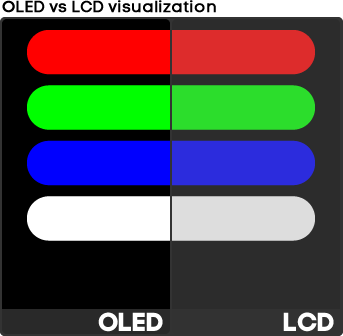AMOLED vs LCD Display
The current era of smartphones belong to 18:9,19:9 displays meaning bigger screens. The screen size of 5.99 inches and plus have also become common, enabling us to do more with our smartphones.
According to Statista,
This is a fact that smartphones have become a part of our daily life, meaning that its impact on our health (especially the young-gen) has become a heated topic of discussion. Everyone has its own take on every aspect related to smartphone (display, use time, apps etc.).
Here, we try to find an answer to one of those questions: Which type of smartphone display hurts our eyes more ? LCD or AMOLED ?
The Basic Comparision
AMOLED display is a screen composed of self-luminous organic materials. It does not require the LCD backlight, because when the beam passes through the organic material, the pixels will self-illuminate. Therefore, compared with the LCD screen, the AMOLED has higher contrast and other display advantages.

However, being more ‘ideal’ also means paying more. The AMOLED displays are thought to cause ‘eyes hurt’ because of low-frequency dimming by AMOLED manufacturers. Here is a simple explanation of PWM low-frequency dimming technology.
DC Low-Frequency Dimming Technology
DC dimming itself is a very straightforward method. But it has obvious drawbacks. As the wavelengths of the three primary colors are different, DC dimming can cause inevitable color casts at the extremely low brightness
The DC dimming and AMOLED screens are even more incompatible. As mentioned earlier, AMOLED displays are self-illuminating technologies that rely on organic materials. Therefore, the display quality of the AMOLED display is directly related to the quality of the screen materials. The color difference between pixels will be clearly demonstrated. Under DC dimming, early models such as the Galaxy S, S2, and Note suffered from uneven white color and serious color casts. What’s sadder, this problem has not been solved well even so far.
PWM Low-Frequency Dimming
Due to the above mentioned reasons, PWM dimming comes out as a substitute. Unlike DC dimming, which directly adjusts the current level to control the brightness, the PWM dimming method is more ingenious. We know that the switching light source causes flickering. But when the frequency of the switching light source exceeds the limit of the human eye, since the luminance information of all the screens is superimposed on each other in the human eye, the speed of the frequency will only affect the brightness of the screen.
However, since PWM dimming is a technique that adjusts the brightness by fast flickering, even if the human eyes cannot perceive the screen changes in the switching process, our brain responds to this phenomenon. Frequent flickering cause fatigue, which stimulates the refraction system to work together to accelerate the aging of vision. Since all current Samsung AMOLED displays use 250Hz low-frequency PWM dimming technology, the lower the screen brightness, the lower the strobe rate, and the greater the possibility of human eyes being able to perceive, making it easier for sensitive people.
Source: GizChina